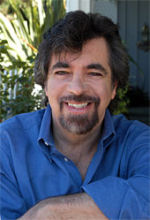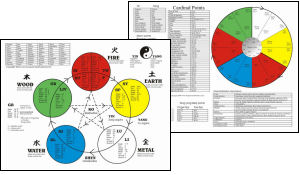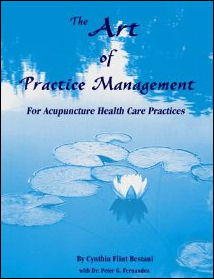Acupuncture & TCM Articles

Neil R. Gumenick is the founder and Director of The Institute of Classical Five-Element Acupuncture. Neil is a Worsley certified advanced teacher of Classical Five-Element Acupuncture and a practitioner with over 27 years of private practice experience. Neil holds three degrees from the College of Traditional Acupuncture (U.K.), and he participated for 10 years in the Master Apprentice Programô, led by Profs. J.R. & J.B. Worsley. Neil has taught at the USC and UCLA Schools of Medicine, the Worsley Institute of Classical Acupuncture, the Traditional Acupuncture Foundation, California Acupuncture College, Santa Barbara College of Oriental Medicine, and Pacific College of Oriental Medicine. He has been a Professor at Emperor's College of Traditional Oriental Medicine and SAMRA University of Oriental Medicine. Neil is co-author of The Art of Practice Management for Acupuncture Health Care Practices
The Teachings of Professor J.R. Worsley, Part Two
By Neil Gumenick, MAc (UK), LAc, Dipl. Ac and Judy Becker Worsley, Dr. Ac. (UK), JD
The Three Levels
Regardless of the Causative Factor (CF), a patient will be imbalanced primarily at the level of body, mind or spirit. Just as no two bodies are the same in any two people, neither are two minds or two spirits.
As with the elements, one cannot analyze a particular behavior and conclude a patient's level. Ultimately, it is the spirit that fuels the body and the mind. Therefore, if a patient makes an obvious mental miscalculation, such as purchasing a lottery ticket as the means of resolving financial difficulties, we cannot simply assume he or she is primarily imbalanced at the mental level. Such an absurdly unlikely financial resolution could well be the last-ditch, desperate attempt by a person whose spirit is very nearly resigned.

One can only perceive the patient's level, and the specific needs within it, from that same level within oneself. One cannot perceive a patient's spiritual needs from one's mind by thinking. Only spirit understands spirit. One's job is to determine, from the whole of oneself, the level that is in most trouble and exactly what the trouble is, and then select the exact points to reach the root of the problem.
The Use of Moxabustion
Artemesia vulgaris latiflora, the herb placed on the skin and ignited to smoldering prior to needling, contains regenerative properties far deeper than mere physical warming. Classical Five-Element Acupuncture states that moxabustion has little to do with heat and much to do with rejuvenation.
A patient may be physically hot, but they may be cold and inert at the level of the mind or spirit. By understanding the needs of the patient, when moxa is used properly, the heat will reach the needed level and therefore balance out all three. Only in cases of hypertension or upon certain specific points is moxa contraindicated. A patient manifesting overheating symptoms on a physical level actually cools down as a result of using moxa appropriately on the needed level.
The Concepts of Tonification and Sedation
J.R. taught that it is impossible to have too much energy. A person is born with a given amount and, although one can rebuild and replenish it, one cannot get "extra." It is, however, quite possible that the available energy within a person is improperly balanced and there may be a relative excess in one area and, thus, a relative deficiency elsewhere. In such cases, the practitioner might to transfer from the relative excess to the relative deficiency in order to assist Nature to restore balance and harmony.
Even in cases in which a syndrome that may seem to be, by its presence, an excess condition, the underlying nature of the person's energy (physical, mental, spiritual) will be deficient. J.R. taught that, in this day and age, the vast majority of patients are imbalanced at the spirit level, regardless of the presence of physical symptoms, and one truly cannot have too much spirit. Thus, in the vast majority of cases, the choice of treatment action will be tonification. By properly treating the CF, the elements within and the level, any concern with so-called "pathogenic factors" dissolves as the power of treating at the cause and level produces seemingly magical results.
In rare cases, all of a patient's pulses may feel excessive. J.R. taught that this means there is internal chaos going on, not that all the organs have too much energy. Once we have given the appropriate treatment to restore calm (in such cases using sedation), we will find that underlying the chaos and panic was, in fact, deficiency.
Awakening Our Senses
J.R. taught that one cannot awaken one's senses merely by wishing and hoping. It takes "presence," achieved through focus and choice. Regarding smell, there is no substitute for consciously smelling a dozen or two things a day in order to reawaken the olfactory sense that one experienced as a young child. The sense of smell "switches on" the entire sensory apparatus. He taught his students to smell everything: papers, plastic, pens, pencils, tea, coffee, etc. Wool smells different than cotton. Oranges smell different than apples. How can one know without this vital sense? He said emphatically, "The patient is there, emitting odor constantly, but what good is it if you can't smell it?"
Regarding seeing, J.R. reminded his students early in their training that most people don't see, they merely look. They take a cursory glance, form an opinion, and off they go. We can only see our patients with our whole being, through the eyes of our own spirit. Only from this state can we perceive the state of our patients' spirits, their level of struggle and suffering, as well as who they are in the fullness of their potential, with their unique divine spark realized. Anything less is just "thinking" that we have the answer (i.e., the CF, level, etc.) and empty of real perception.
It is the same with touch. In the course of a treatment, there are many opportunities to make physical contact with a patient. Is the contact merely physical, or does it touch the mind and spirit as well? Is the practitioner's physical communication appropriate, arising from a genuine impulse within? Is it consistent with the words, the tone of voice, the emotion and the facial expression? If mixed messages are given, mixed and confusing answers will result.
These sensory skills are natural, effortless, and available to all. However, they are beyond the reach of the intellect and irreplaceable by thinking. From the senses, one can actually know the patient and what he or she really needs to take the next steps on the journey. From the head, one can only imagine, speculate and guess. Having a head filled with correspondences, categorizations and expectations is not being present to anything but one's own mind. However, when responding to each moment innocently - without preconceptions, expectations or an agenda, without "trying" to do anything (including trying to "get it right" and to "look good") - then one is present to the patient, wholly and completely.
Crafting a Successful Treatment
J.R. taught in the tradition of Master Teacher. He personally demonstrated and showed each student how to translate the sensory information into a precise treatment plan to meet the needs of the patient. He taught the physical, mental and spiritual dimensions of every element and Official (organ/function). He brought the spiritual connotations of each point to life. He gave students individual feedback on pulse taking and point location, and shared his own findings as a standard against which his students could measure their own sensitivity. With ongoing practice, students found their pulse diagnoses and point location congruent with his. He gave students the benefit of his own sensory experience and choice of points, in such a way that they deeply understood not only why, but how he arrived at his conclusions.
Removing Our Internal Obstacles
Finally, J.R invited his students to drop all of their excuses. Bringing the ancient teachings of the Chinese sages to life, he taught that the results we get depend on the core beliefs we hold. If we as practitioners believe, for example, that we cannot smell, we create that result as reality for ourselves. He taught that we have the responsibility for our own learning. Nothing is stopping us but ourselves.
Our perceptions and interpretations are ours, as well as any self-imposed limitations. It is untrue that anyone or anything out there is challenging and needs to change. We challenge ourselves by resisting, interpreting, labeling, distorting and blaming. With responsibility, we see that we, not the outside world, need to change. With this realization, we put ourselves at cause. To imagine otherwise is to embrace excuses, to act as impotent victims, simply at the effect of events and circumstances over which we feel we have no control. Thus, we come face to face with our own issues and beliefs - how our minds create an illusion of separateness between us and our patients, the world around us, and our God-given senses. Recognizing how we create disconnectedness is itself the way out of the mind trap of enslavement to the past, fear of the future, and into the purity and authenticity of the present.
Ultimately, he taught his students to love one another, to see beyond the false self and the notions of separateness to the essence beneath. We might not like everyone, but we are still connected by a single life energy. When we feel the connection, we are "in" the energy. We are "in love," for love is the connection and the oneness. Ultimately, any notion of separation between "others" and us is illusory. He taught, "In God's eyes, we are all equal, so for God's sake, don't look down on anyone or up to anyone, because anything you think they've 'got,' you've got in spades, as well."
The fact that we exist on a level of physical appearances and separate forms simply means we have more work to do on ourselves. The good news is we have so many opportunities to do the work - so many people and situations to thank for revealing our false selves, for "pushing our buttons" so that we can know these buttons are there and resolve them. This stripping away of ego, admittedly, can be painful, but what an incredible liberation it is. This becomes the profound focus for our development as better and better instruments of Nature.
The History, the Future
J.R. received this lineage from his Master Teachers, Master Ono and Master Hsui, with whom he studied in the Far East in the 1950s and 1960s. He always asserted, "Classical Five-Element Acupuncture is nothing I have invented. I am simply passing along this system as it has been practiced for thousands of years. It is based on natural laws that do not change and will not change." He passed the responsibility of teaching this lineage to Judy Becker Worsley, his wife, his student, trustee of his intellectual property and his designated successor. In the last 31 years Judy was at his side, learning with him. He announced two years before his death that we were no longer to consider him the sole Master and Judy in a lesser role. She was to be the new Master, absolutely his equal, and she had fully embodied the teachings.
In 1997, J.R. and Judy invited a group of senior practitioners to become "apprentices," thus creating the Master Apprentice Program (MAP), which is dedicated to developing leaders, teachers and protectors of the Classical Five-Element Acupuncture lineage as taught by J.R. The MAP participants, dedicated to preserving the integrity of this system of medicine following J.R.'s death, established the not-for-profit Worsley Institute to protect the accuracy and integrity of his teaching and make it widely available. There currently are five designated Master Apprentices and 10 Apprentices. A second MAP was initiated in 2002, with 37 practitioners currently enrolled.
There is no need for speculation about who will carry forward the Classical Five-Element Acupuncture lineage. J.R. honored his oath to his teachers - to practice and teach Classical Five-Element Acupuncture as it has been taught for thousands of years - until his last breath. Judy and all the Master Apprentices and Apprentices have pledged the same oath: to preserve, teach and express the ideals of this Classical Five-Element Acupuncture lineage.
Please visit the Worsley Institute Web site (www.worsleyinstitute.org) for information on Professor Worsley's charts, tapes, books and other upcoming events that teach his work.
 
The Art of Practice Management for Acupuncture Health Care Practices
What you will find in this book is a specific, comprehensive approach that gets to the root cause of success in practice.
This new book presents acupuncture practice as art from the standpoint of centering, qi, and wholeness. It builds on the premise that practices succeed from bridging inner and outer aspects of the self. It is an inquiry into the self and addresses clear understandings and approaches to reputable patient care and practice qi. It brings in the five elements and work with the seasons of practice from training and start-up to growth, stability, expansion and transformation. The authors artfully bridges the essence of both patient and practitioner well-being without excluding the practicalities of financial well-being. This book very specifically and extensively shows how the different parts of practice nourish and feed one another and are interdependent on one another for the qi to flow synchronistically.
It explores the dual nature of procedures that work and those which do not in acupuncture health care practice, returning again and again to the delicate balance of practicality and spirituality.
|
